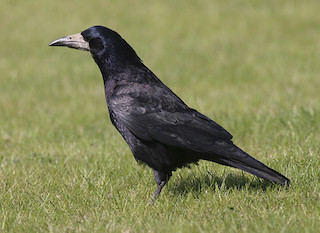 Rooks, familiar across the British countryside, have an important place in our folklore, but are a fascinating bird in their own right.
Rooks, familiar across the British countryside, have an important place in our folklore, but are a fascinating bird in their own right.
Photo: © Natural England/Allan Drewitt
Scientific name: Corvus frugilegus
Conservation status: IUCN Red List, Least Concern
 There’s a saying: “If you see one Rook, it’s a Crow; if you see lots of Crows, then they’re Rooks.” While a little bit of an over-simplification, this is based on real behaviour of these two corvid species: Rooks are far more gregarious than their more ‘anti-social’ cousins. (Why over-simplification? Carrion Crows are in fact often seen in pairs, and will sometimes roost in groups in the winter, though in smaller roosts than Rooks.)
There’s a saying: “If you see one Rook, it’s a Crow; if you see lots of Crows, then they’re Rooks.” While a little bit of an over-simplification, this is based on real behaviour of these two corvid species: Rooks are far more gregarious than their more ‘anti-social’ cousins. (Why over-simplification? Carrion Crows are in fact often seen in pairs, and will sometimes roost in groups in the winter, though in smaller roosts than Rooks.)
The main way to tell apart a Rook and a Carrion Crow is the bare grey-white skin around the bill in adults of the former (this is absent or less pronounced in juveniles). Rooks are also generally less stocky, with a thinner beak, and have a distinctive peak to their crown.
Found throughout Britain, Europe and Asia, a group of Rooks is a familiar sight feeding in fields or along roadsides, searching for worms, invertebrates, larvae and grain (the species name of frugilegus means ‘food-gathering’). Even more familiar are their noisy colonial rookeries in the nesting season, established in the treetops: you can often hear them before you see them!
Clutches of three to five eggs are laid in March in nests constructed of twigs, and the young are fed by both parents: they are fully fledged at about 40 days old, but remain partially dependent on their parents for up to five months. In winter, birds from different breeding colonies join together to form much larger roosts, sometimes of thousands of birds, creating an unmissable (and loud) spectacle.
Did you know…?
…There are a few collective nouns for Rooks, including ‘a building’, ‘a parliament’, ‘a clamour’ and, my favourite, ‘a storytelling’.
…Rooks, like other corvids, are intelligent and can use tools to achieve a desired goal. In captivity they have, for example, been observed to bend a wire into a hook in order to reach an item of food.
…According to folklore, bad luck will come to a person if Rooks abandon a rookery on their land. It was also believed that Rooks could forecast weather and sense when death was approaching.
More information and references:
Gooders, J. and Harris, A., 1986. Field Guide to the Birds of Britain and Ireland. Kingfisher Books, London.
Published: January 2014 (updated August 2020)
Author: Amanda Scott
Photos: © Natural England/Allan Drewitt
